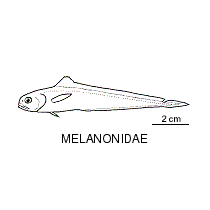- Classification
- ACTINOPTERYGII
- GADIFORMES
- MELANONIDAE
-
Fish Classification
-
Class
ACTINOPTERYGII Ray-finned fishes -
Order
GADIFORMES Cods, grenadiers -
Family
MELANONIDAE Pelagic Cods -
Genera
Melanonus(2)
Family MELANONIDAE
More Info
|
Family Taxonomy |
Family with a single genus and two species, both in Australian waters. |
|
Family Distribution |
Restricted to temperate and subantarctic waters of all oceans; meso- and bathypelagic far from shore in 150-6300 m; one species in Antarctic waters. |
|
Family Description |
Body long, slender, tapering to a very narrow caudal peduncle; head blunt, with many small, fleshy ridges and large lateral-line pores; chin barbel absent; single dorsal and anal fins long-based, posterior segments of both fins sometimes detached; caudal fin separate, slightly rounded; pelvic fin below and just before pectoral-fin base, rays connected by membrane, fin not reaching anus; anus just before anal-fin origin; scales small, cycloid, absent from dorsal and anal fins. |
|
Family Size |
To about 28 cm |
|
Family Reproduction |
Little known of life history. The spawning, eggs and larvae are unknown; the smallest described stage is a 15 mm SL juvenile with a dark body, small eyes, all fins formed and a similar body shape to adults. |
|
Family Commercial |
No commercial catch, rarely taken even by deep commercial trawlers. |
|
Family Diagnostic |
Externally very similar to morid cods, differing internally in having a modified caudal skeleton and lacking a complete connection between swim bladder and auditory part of skull. Body elongate, tapering, caudal peduncle extremely slender; head blunt, with many small, fleshy ridges, chin barbel absent; dorsal fin long-based with raised anterior portion tapering rapidly, then following dorsal profile; anal fin similar to posterior part of dorsal fin but lower; posterior segments of dorsal and anal fins sometimes detached; pelvic fin originating below and just before pectoral-fin base, rays connected by membrane, fin not reaching anus; caudal fin rounded slightly; anus adjacent to anal-fin origin; scales small, cycloid, absent from dorsal and anal fins. |
References
Cohen, D.M. 1986. Family 91: Melanonidae, pp. 328-329, In Smith, M.M.& P.C. Heemstra. (eds.) Smiths' Sea Fishes. Macmillan South Africa, Johannesburg. 1047 pp.
Fahay, M.P. & D.F. Markle. 1984. Gadiformes: development and relationships, pp. 265-283. In Moser H.G., W.J. Richards, D.M. Cohen, M.P. Fahay, A.W. Kendall, Jr. & S.L. Richardson (eds). Ontogeny and Systematics of Fishes. Am. Soc. Ichthyol. Herpetol. Spec. Publ. No. 1. Allen Press Inc. Lawrence, USA.
Howes, G.J. 1991. Anatomy, phylogeny and taxonomy of the gadoid fish genus Macruronus Günther, 1873, with a revised hypothesis of gadoid phylogeny. Bull. Br. Mus. (Nat. Hist.) Zool. 57(1): 77-110.
Lindquist, D.C., R.F. Shaw & T. Farooqi. 2006. Melanonidae: Pelagic Cods, arrowtails, pp. 629-631 In Richards, W.J. (ed). Early Stages Of Atlantic Fishes: An Identification Guide For The Western Central North Atlantic. CRC Press, Taylor and Francis Group, Boca Raton, FL, 2640 pp.







